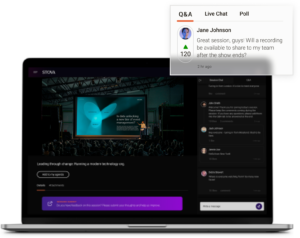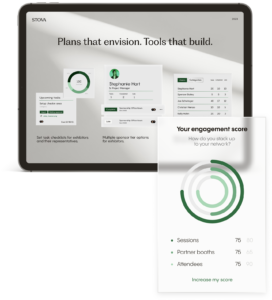Maximizing the Value of Post-Event Engagement
March 30, 2023
After the last guest leaves the venue or logs off the meeting platform, you may be tempted to celebrate the close of another event. But your work isn’t over. Keep that coffee brewing and dig your heels in, because what you do next can either make or break the event’s success. With the planning and execution stages complete, now it’s time to focus on your post-event engagement strategy.
What is a post-event strategy?
Everything you do to keep the momentum going after your event is part of your post-event strategy. It encourages attendees, exhibitors, or sponsors to stay in touch with your brand long after the event ends. It can also further drive your return on investment by converting attendees to customers. Your post-event engagement strategy should focus on three key activities:
-
Build relationships.
Establishing effective communications to nurture business relationships is a critical component of post-event follow up communications.
-
Get event feedback.
Gather valuable post-event insights and gauge attendee satisfaction. This feedback also helps you understand what worked and what didn’t.
-
Move forward with data.
Analyze event results and make data driven decisions that can impact future marketing decisions.
This strategy can have multiple approaches, which we will talk about soon. Ultimately it seeks to achieve or exceed your team’s event goals.
Why is post-event engagement so important?

Capitalizing on a successful event should not be left to the last minute. Post-event marketing is one of the most important aspects of event planning – it’s right up there with pre-event marketing. Why is it so important? Here are a few stand-out reasons:
It continues the conversation.
After attending your event, interested attendees will likely want to engage and establish a connection. But they don’t want to reach out first. Lead with a strategy to initiate and continue conversations that build trust, loyalty, and nurture these important business relationships.
It helps your sales team qualify leads.
Not every attendee is a good fit for your brand or for future events. Use post-event feedback such as chat or poll participation to gauge interest and better predict who wants to do business. With this knowledge, you’ll be equipped to nurture event leads and gain loyal customers.
It increases your brand’s reach and engagement.
After an event, you’ll likely have a treasure chest of content. Publish it in several places such as emails campaigns, newsletters, social media, and video platforms to extend your brand’s reach. Post-event social media content not only boosts visibility and engagement, but also reaches people who didn’t attend the event — and now wish they did!
It aims to achieve your event goals.
Your engagement strategy should cover activities before, during, and after your event, working congruently to accomplish your team’s guiding goal(s). Personalized follow ups, sharing popular event content, asking questions in post-event surveys, can all move the needle closer to making the next sale, converting an attendee into a loyal customer, and increasing ROI. With future events in mind, use data points to begin formulating a recipe for even bigger success next time.
In short, your post-event strategy is what keeps a successful event from falling flat. Don’t skip it! Now that you know why post-event engagement is so important, let’s dive in to how it’s done.
What are some post-event engagement examples?

While you don’t have to do it all, it is useful to implement a mix of techniques. Here are some of our favorite ways to stay in touch with your audience after an event.
Thank You’s
The best place to start is from a place of gratitude. Without attendees, exhibitors, and sponsors, you wouldn’t have an event. They traveled, rearranged schedules, gave up personal time, paid money, and possibly helped spread the word. Acknowledge this value with a thank you. It can be posted on your event website, social media channels, and/or included in a follow-up email or text message.
Post-Event Surveys
Get reliable feedback directly from your audience. You can ask them to rate their experience or ask post-event feedback questions that are opened ended, scaled, or multiple choice. Check out our blog for some sample survey questions to ask attendees or discover tips on creating an experiential post-event survey. To summarize, be sure to ask the right people, determine clear survey goals, and use best writing practices by keeping the survey-taker’s experience in mind.
Emails
Emails can be your greatest tool for post-event communication. And persistence generally pays off, so consider sending more than one in a drip marketing campaign. You can even send emails to those who didn’t attend. A “sorry we missed you” message can include some must-see event content and other highlights. With proper planning, you can send the perfect post-event follow up emails that will generate responses. This becomes even easier if you use a custom event solution that integrates with your existing CRM.
Content Sharing
Events generate a ton of quality content, especially virtual or hybrid events which provide hours of recorded/pre-recorded sessions. Whether written, visual, or audial, be sure to share this content wherever you can. Attach a presentation slide deck to an email, feature event highlights in your newsletters, post video reels to social media, and publish important documents to your event’s website. Remember to edit these pieces into bite size chunks for easy sharing. Taking it a step further, your content can live longer if you create clips, infographics, memes, or inspirational quotes for future marketing campaigns.
There are several ways to engage after an event, and we know you want to execute with precision. To help optimize your approach, we can share some best practices to bring your post-event marketing strategy to the next level.
What are post-event engagement strategy best practices?
There’s a lot of competition out there. Set your post-event management style apart. Engage your attendees, exhibitors, or sponsors with these best practices.
1. Leverage event momentum.
Don’t let good event vibes die. Begin post-event activities right away. It does not take long for attendees to forget and move on. In fact, researchers say that while you’re busy basking in the success of an event, attendees are quickly forgetting most of what was presented to them. W one hour people will have forgotten about 50 percent of the information that they heard. Within 24 hours, they forget an average of 70 percent, and within a week, 90 percent of it is gone from an attendee’s memory. Early engagement is the key to staying relevant!
2. Create a timeline.
Be persistent (but not annoying) with engagement. Schedule touchpoints over a mix of platforms during the first two weeks or so after an event. While different factors can influence your marketing decisions, a timeline could look like this:
Day 1-2: Send a ‘Thank You’ email. Show gratitude by offering something of value, like exclusive access to additional content, a promo code for a future purchase, or a discount to the next event. Update social media pages with event highlights tagging your partners. Provide summaries for those who were unable to attend.
Day 3-4: Use your event management platform to automate an SMS message with a link to a brief satisfaction survey for a chance to win a giveaway or admission to the next event. On social media, ask attendees to share photos and videos from the event.
Day 5-6: Begin an email nurture campaign. Share more content, offer promotions, talk about upcoming events, attach useful downloads, or point readers to additional resources. Continue to engage on social media by reposting user generated content.
Day 7-8: Invite attendees who have not done so already to sign up for newsletters, blogs, and/or memberships. Offer educational or desired topical content that will entice your audience to stick around for more. Reinforce the opportunity for continued learning on social media. Use event photography to create clips, infographics, or memes to share event takeaways.
Day 10-12: Reach out with a phone call. Gauge responsiveness and invite your sales team members to follow up potential leads with a call. Continue to engage on social media. Invite people to like, share, hashtag and repost. Tag your event partners.
3. Put Data to Use
Once you gather data, don’t let it go to waste. Analyze it, share it with your team, calculate your return on investment, and drive future event planning decisions backed by data. What you learn here can improve your planning strategies, event offerings, timelines, and even budget.
Recap
Now you that you know:
- Post-engagement strategies build relationships, provide feedback, and generate useful data for future events.
- Post-event engagement is critical to your planning strategy. What you do after your event facilitates meaningful connections and lead qualification, boosts audience reach, and brings your event goals across the finish line.
- There are many ways to engage after an event. You can say thank you, conduct surveys, send emails, and share event content, especially on social media.
- Implement best practices to make your post-event activities successful. Start early, engage often, and be open to learning from and leading with data.
With the right tools and support from event professionals, elevate your engagement strategies to realize goals and growth. Stova empowers you stay engaged long after you event is over. Request a demo to see how it works.
Whether your event is virtual, hybrid, or in-person, enhance your attendee’s journey with an event ecosystem built for your audience. Ready to walk through Stova's event technology solutions? Schedule some time with us today.

